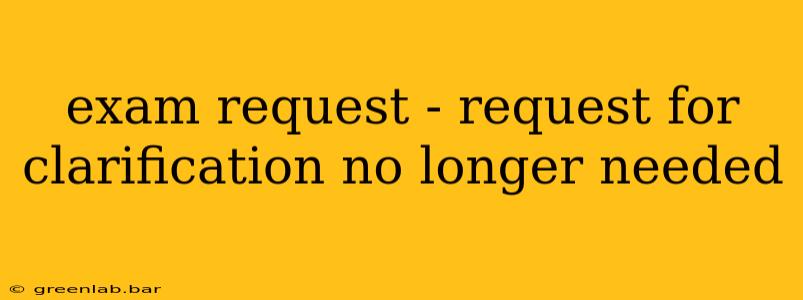This post addresses the common scenario of submitting an exam request and subsequently finding that the initial request for clarification is no longer necessary. It provides guidance on how to proceed efficiently and professionally.
Understanding the Situation
Many institutions require formal exam requests, often involving detailed information about the exam itself and the reasons for the request. Sometimes, after submitting the initial request, you might realize that the questions or concerns you had have been resolved independently. This could be due to finding information elsewhere, receiving clarification from a classmate or professor, or simply gaining a better understanding of the material.
How to Proceed: The Best Practices
When your initial questions are answered and the clarification request is no longer needed, you should not simply ignore your initial submission. Instead, follow these steps to maintain professional communication and streamline the process:
1. Notify the Relevant Authority
Contact the individual or office responsible for processing exam requests. This might be a professor, an exam coordinator, or an administrative department. Clearly state that the clarification request is no longer necessary as the issue has been resolved.
2. Keep it Concise and Professional
Your communication should be brief, polite, and to the point. A short email is usually sufficient. For example:
Subject: Exam Request Clarification - [Your Name] - [Exam Name/Number]
Dear [Recipient Name],
This email is to inform you that the clarification request I submitted earlier regarding the [Exam Name/Number] exam is no longer required. I have resolved the issue independently.
Thank you for your time and consideration.
Sincerely,
[Your Name] [Student ID Number]
3. Maintain a Record
Keep a copy of your initial request and this follow-up email for your records. This can be helpful for future reference or in case any unforeseen issues arise.
4. Avoid Ambiguity
Ensure your message is clear and unambiguous. Leaving any room for misinterpretation can lead to unnecessary delays or confusion. Specifically mention the exam request you are referring to, making it easy for the recipient to identify and update their records.
Why This Matters: Professionalism and Efficiency
Following these steps demonstrates professionalism and respect for the administrative processes involved. It frees up time for both you and the institution, avoiding unnecessary back-and-forth communication and ensuring a smoother exam process for everyone involved. By proactively addressing the situation, you contribute to a more efficient and organized academic environment.
Conclusion
Handling a situation where your clarification request is no longer needed is a simple yet crucial aspect of academic interaction. By communicating effectively and professionally, you maintain positive relationships with the administrative staff and ensure a streamlined process for your exam. Remember, clear and concise communication is key to resolving such situations quickly and efficiently.

